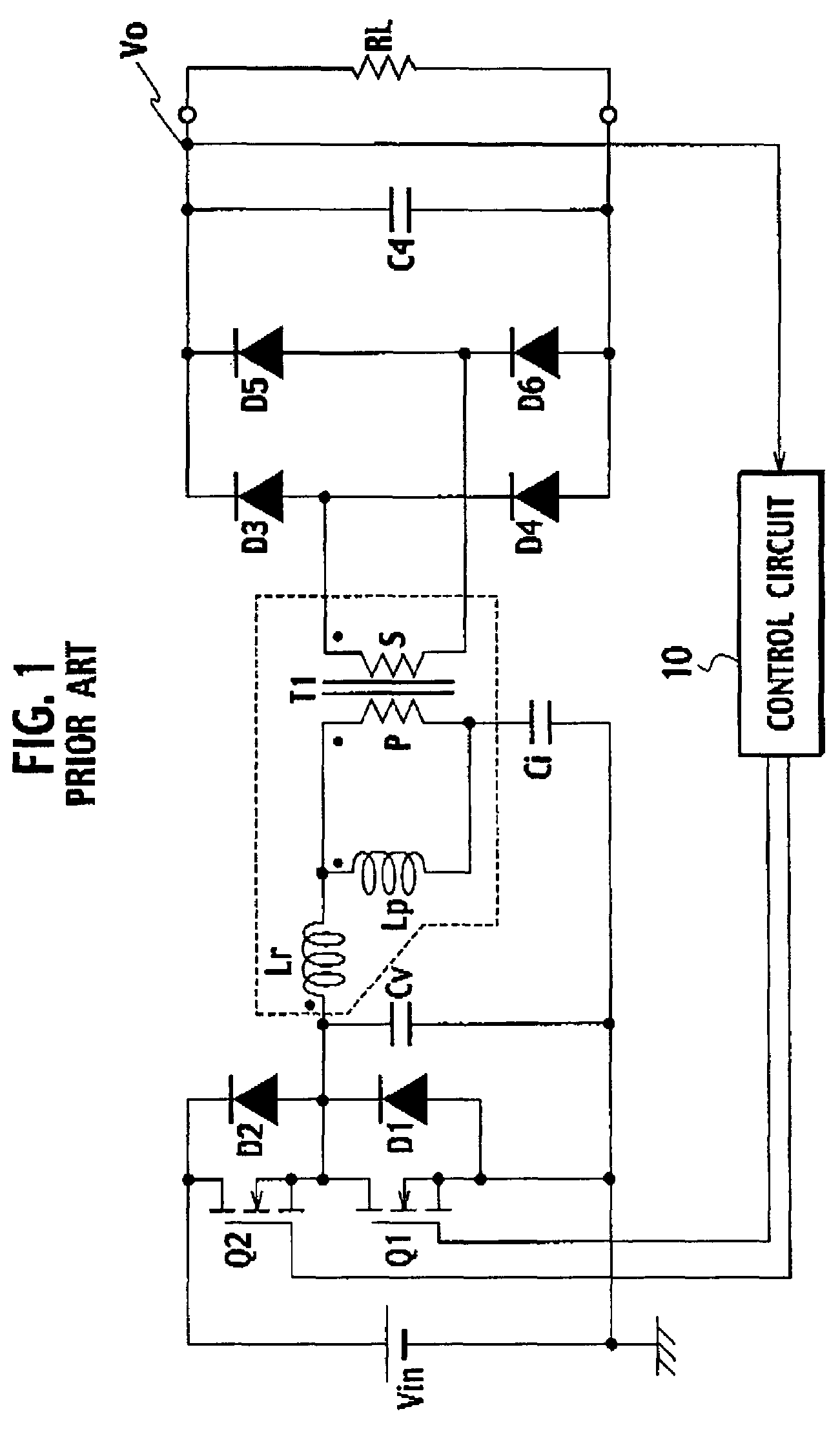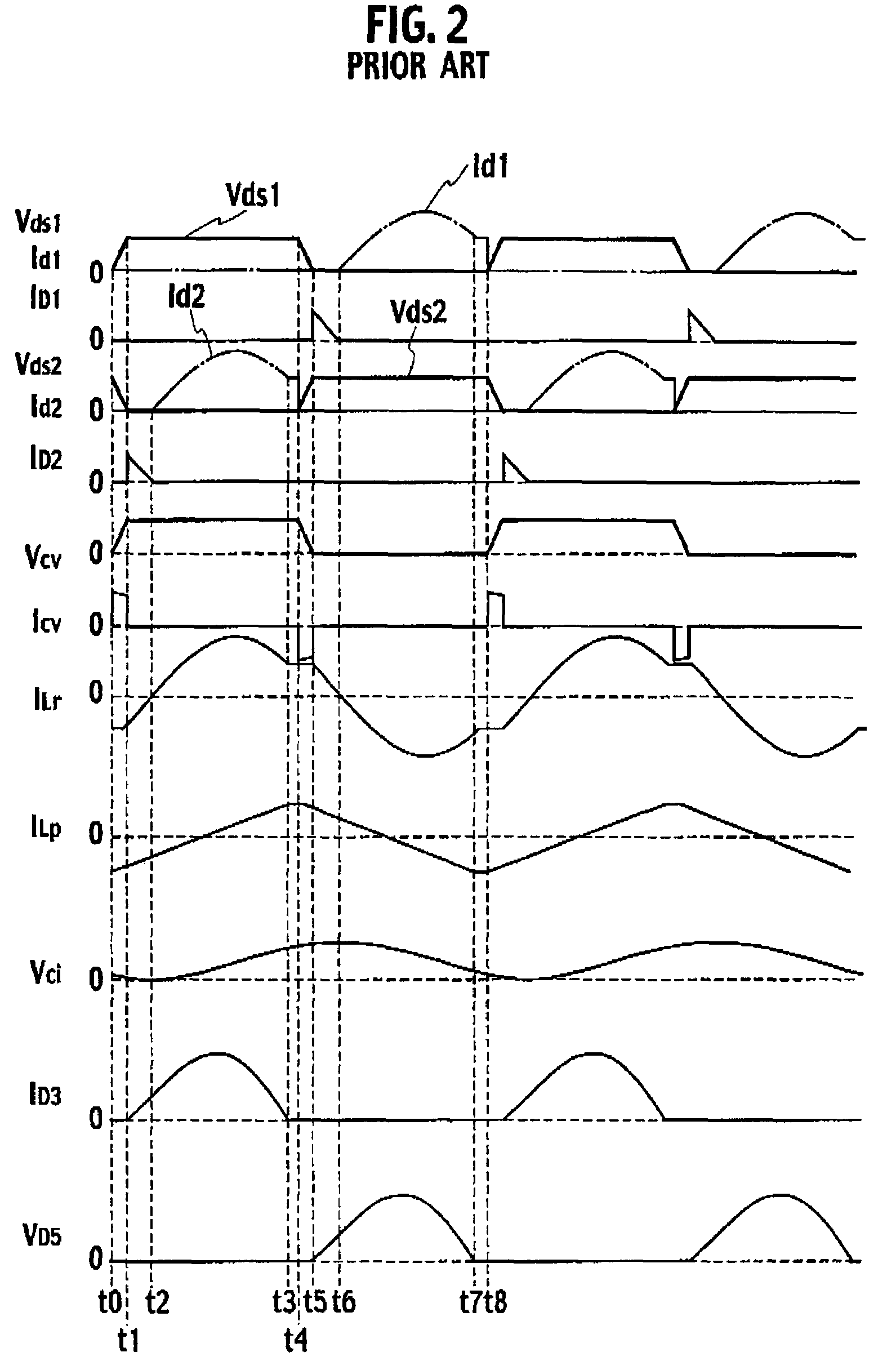Direct-current converter
a converter and direct current technology, applied in the direction of electric variable regulation, process and machine control, instruments, etc., can solve the problems of reducing the output voltage of the converter, affecting the efficiency of the d.c. converter, and the disadvantage of the large d.c. converter, so as to achieve the effect of reducing the output voltag
- Summary
- Abstract
- Description
- Claims
- Application Information
AI Technical Summary
Benefits of technology
Problems solved by technology
Method used
Image
Examples
first embodiment
[0040]The operation of the D.C. converter of the first embodiment will be described below. Note that the principle of picking up the output voltage Vo from the transformer T1 is similar to that of the conventional D.C. converter described with reference to FIGS. 1 and 2. Thus, we are concerned here only with the reason why four times as much voltage as the voltage Vin of the D.C. power source is generated between both ends of the primary winding P of the transformer T1.
[0041]In the high-frequency converter circuit of FIG. 3 (including the transformer T2, the switching element Q1 and the switching element Q2), the switching element Q1 and the switching element Q2 repeat their ON / OFF states alternately to each other while interposing a “dead-time” period when these elements Q1, Q2 are turned OFF together.
[0042]When the switching element Q1 is turned ON while the switching element Q2 is turned OFF, the transformer T1 is provided, at one end (●: on the winding-start side) of the primary...
second embodiment
[0047]FIG. 4 is a circuitry diagram showing a direct-current (D.C.) converter in accordance with the present invention. This D.C. converter differs from the above-mentioned D.C. converter in that a series resonant circuit composed of the primary winding P of the transformer T1 and a capacitor C1 is interposed between one connection point between the first winding n1 of the transformer T2 and the drain of the switching element Q1 and another connection point between the second winding n2 of the transformer T2 and the drain of the switching element Q2.
[0048]In spite of the above difference, the operation of the D.C. converter of the second embodiment is similar to that of the D.C. converter of the first embodiment, allowing the similar effect to be afforded.
embodiment
3rd. Embodiment
[0049]FIG. 5 is a circuitry diagram showing a direct-current (D.C.) converter in accordance with the third embodiment of the present invention. In the D.C. converter of the third embodiment, a voltage resonant capacitor Cv is connected in parallel with the connection point between the first winding n1 of the transformer T2 and the drain of the switching element Q1 and the connection point between the second winding n2 of the transformer T2 and the drain of the switching element Q2. Further, the D.C. converter includes a series resonant circuit where the primary winding P of the transformer T1, a current resonant capacitor Ci and a reactor Lr are connected with each other, in series. This series resonant circuit is connected in parallel with the former connection point and the latter connection point. The reactor Lr is formed by a leakage inductance between the primary side and the secondary side of the transformer T1. A reactor Lp is connected in parallel with the pri...
PUM
 Login to View More
Login to View More Abstract
Description
Claims
Application Information
 Login to View More
Login to View More - R&D
- Intellectual Property
- Life Sciences
- Materials
- Tech Scout
- Unparalleled Data Quality
- Higher Quality Content
- 60% Fewer Hallucinations
Browse by: Latest US Patents, China's latest patents, Technical Efficacy Thesaurus, Application Domain, Technology Topic, Popular Technical Reports.
© 2025 PatSnap. All rights reserved.Legal|Privacy policy|Modern Slavery Act Transparency Statement|Sitemap|About US| Contact US: help@patsnap.com



